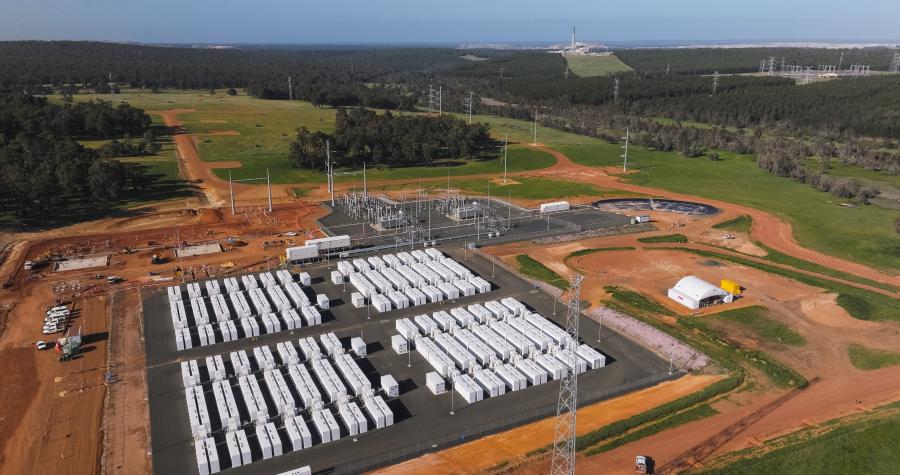Storing renewable energy: battery storage

Battery storage is an essential part of the energy transition. In addition to playing a role in helping to stabilise the electricity grid, it ensures we have clean, reliable power – even when the sun isn’t shining and the wind isn’t blowing.
What is a battery energy storage system?
A battery energy storage system (BESS) is a rechargeable battery system that stores energy from various sources, such as renewable energy (solar power or wind energy) or the grid, and is then discharged when it is needed.
Role of battery energy storage systems
Unlike wind and solar, batteries can release stored power when needed and they can react quickly, providing energy to the grid. Combining battery storage with wind and solar farms helps overcome the intermittent nature of renewable energy by storing excess power when production is high and releasing it during peak demand. This ensures a steady supply of power at all times.
What are community batteries?
Community batteries are shared energy storage systems that serve households and businesses. Unlike individual home batteries, they are installed in a central location within a community and connected to the local electricity network.
Community batteries reduce energy costs, improve grid stability, lower emissions and offer shared access to clean energy. This option makes renewable storage more affordable and accessible for entire neighbourhoods – even those who don’t have solar panels can still enjoy the benefits.
The role household batteries will play in the energy transition
Home batteries store energy from solar and release it to the household when needed.
Household batteries will:
- help families save on electricity bills by using solar power when they need it
- give families more control over their energy use and reduce their dependence on the grid
- reduce costs for everyone, not just those who install a battery, as it means less need for expensive gas or coal power generation, poles and wires.
Through the Cheaper Home Batteries Program households and small businesses may be eligible for around a 30% discount on the upfront cost of installing a small-scale battery.
The role of large-scale batteries in the energy transition
Large-scale batteries are playing a pivotal role in Australia’s transition by bringing about greater integration of renewable energy into the grid.
Unlike home batteries, large-scale batteries can store hundreds of megawatts of energy. This is enough to supply electricity to thousands of homes or even cities during peak demand or outages.
Australia has been a global leader in big battery projects. In 2017, the world’s first large-scale battery was built in South Australia. The Hornsdale Power Reserve project demonstrated how batteries could provide grid stability, store excess renewable energy and help reduce electricity bills. In its first 2 years of operation the battery saved South Australian consumers over $150 million.
The success of this battery project has paved way for numerous other large-scale battery projects across the country.
Australian large-scale battery projects
In Collie, a region historically dependent on coal-fired power generation, 2 large-scale battery projects will be instrumental in supporting electricity reliability as Western Australia transitions to renewable energy.
The Neoen Collie Battery is a 560 MW battery (219 MW from stage 1 and 341 MW from stage 2). Stage 1 started operating in October 2024 and stage 2 has been operating since July 2025. The battery will have the ability to charge and discharge 20% of the average demand placed on Western Australia’s transmission network. Synergy’s Collie Battery Energy Storage System will be completed by the end of 2025 and will provide around 500 MW of power when fully charged.
Large-scale battery projects are also underway in other parts of the country.
In the Latrobe Valley, the Hazelwood Battery Energy Storage System (HBESS) is a 150 MW battery situated near the former site of the Hazelwood Power Station. It has the capacity to store the energy equivalent of an hour of energy generation from the rooftop solar systems of 30,000 Victorian homes.
In Rockhampton, Central Queensland the Bouldercombe Battery Project, is a 50 MW battery that will power more than 4,000 homes and offset over 22,000 tonnes of CO2 per year.
In NSW, the Waratah Super Battery project located on the site of the former Munmorah coal-fired power station will be capable of supplying 970,000 homes with electricity to help prevent blackouts in the state by acting as a shock absorber for the electricity grid.
Battery storage projects benefit regions
Aside from helping regions meet their energy needs, battery storage projects offer a range of social and economic benefits.
Job creation – battery storage projects create jobs in construction, engineering and electrical work during installation. Long-term roles include technicians, control room operators and maintenance staff.
Synergy’s Collie Battery created more than 500 jobs during its construction phase, with 50 people from the local region. And in the Latrobe Valley, the Latrobe Valley BESS will create up to 150 direct and 240 indirect jobs during construction.
Educational benefits – Neoen Collie Battery has developed educational resources for local schools to support learning about renewables and our future energy system.
Community investment – Synergy has a community investment program and has delivered more than $200,000 worth of investment to grassroots groups in the Collie community.
